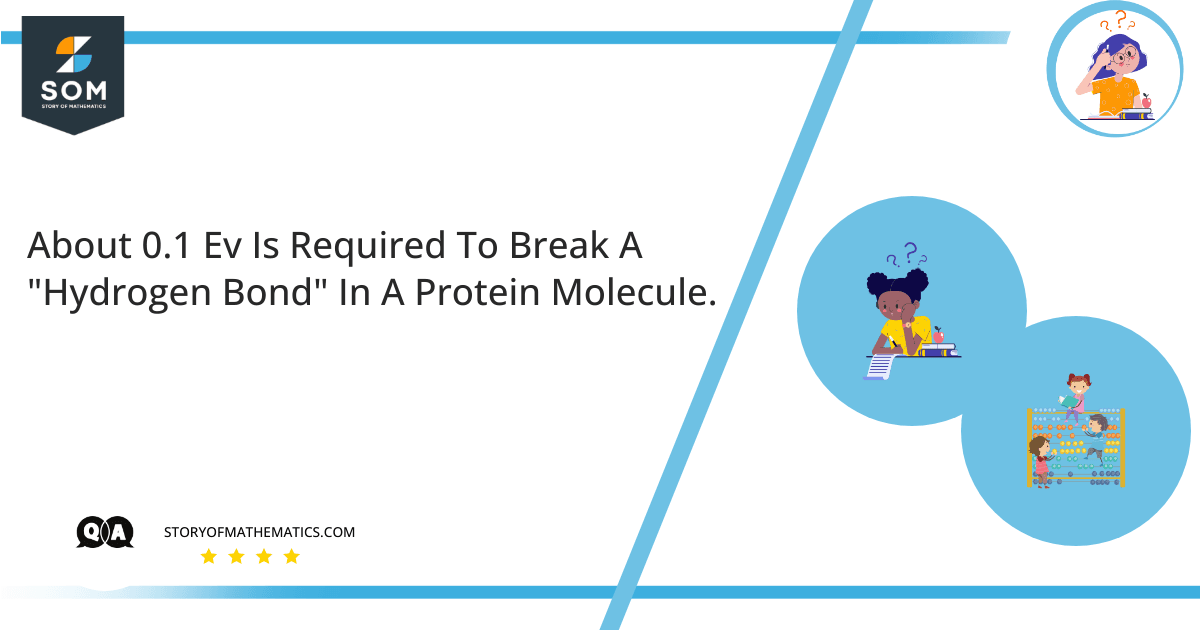
- Calculate the minimum frequency of photon that can break a Hydrogen bond.
- Calculate the maximum wavelength of a photon that can break a Hydrogen bond.
The question aims to find the minimum frequency of a photon and its maximum wavelength that can break a Hydrogen Bond of a protein molecule.
The concepts needed to solve this problem include Planck’s Equation and photon’s (the smallest particle or packet of light) frequency using Planck’s equation. The equation is given as:
\[ E = h v \]
It can also be written as:
\[ E = h \dfrac{ c } { \lambda } \]
Expert Answer
a) The energy of the photon is given as:
\[ E = 0.1 eV \]
To calculate the correct value, we need to convert the unit of energy from $eV$ to $J (Joules)$. It is given as:
\[ 1 eV = 1.6 \times 10^ {-19} J \]
\[ 0.1 eV \times 1 eV = 0.1 \times 1.6 \times 10^ {-19} J \]
\[ 0.1 eV = 1.6 \times 10^ { -20 } J \]
We can use Planck’s Equation to calculate the frequency of the photon, which is given as:
\[ E = h v \]
Here, $v$ is frequency of the photon, $E$ is the energy of the photon, and $h$ is Planck’s constant. The value of the Planck’ constant is given as:
\[ h = 6.626 \times 10^ { -34 } Js \]
Rearranging the formula to calculate the frequency of the photon is given as:
\[ v = \dfrac{ E }{ h } \]
Substituting the values in the given formula, we get:
\[ v = \dfrac{ 1.6 \times 10^ { -20 } J }{ 6.626 \times 10^ { -34 } Js } \]
Solving the equation, we get:
\[ v = 2.4 \times 10^ {13} Hz \]
b) To calculate the wavelength of the photon, we use the other form of the equation where the frequency is replaced by the speed of light and wavelength of the light. The equation is given as:
\[ E = h (\dfrac{ c }{ \lambda }) \]
The speed of light is given as:
\[ c = 3 \times 10^ { 8 } m/s \]
Rearranging the formula to calculate the wavelength of the photon as:
\[ \lambda = \dfrac{ hc }{ E } \]
Substituting the values, we get:
\[\lambda = \dfrac{ (6.626 \times 10^ { -34 } Js) . (3 \times 10^ { 8 } m/s) }{ 1.6 \times 10^ { -20} J }
Solving the equation, we get:
\[ \lambda = 1.24 \times 10^ { -5 } m \]
Numerical Result
a) The minimum frequency of the photon required to break a hydrogen bond in a protein molecule while the energy of the photon is $0.1 eV$ is calculated to be:
\[ v = 2.4 \times 10^ { 13 } Hz \]
b) The maximum wavelength of the photon to break a hydrogen bond in a protein molecule while the energy of the photon is $0.1 eV$ is calculated to be:
\[ \lambda = 1.24 \times 10^ { -5 } m \]
Example
Find the frequency of the photon with an energy of $5.13 eV$, which is required to break an oxygen bond in $O_2$.
The formula is given as:
\[ v = \dfrac{E}{h} \]
\[ v = \dfrac{5.13 \times 1.6 \times 10^{-19} J}{6.626 \times 10^{-34} Js}\]
\[ v = 1.24 \times 10^{15} Hz \]
